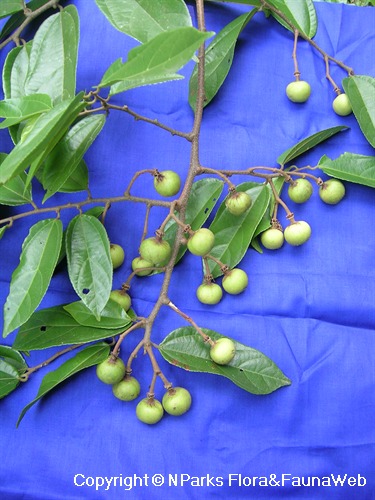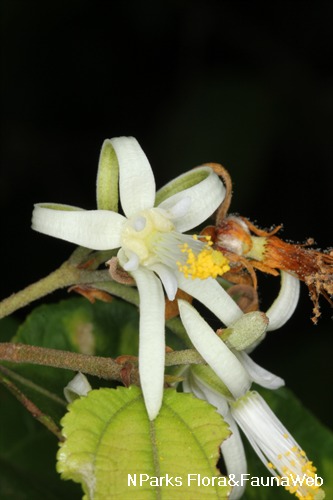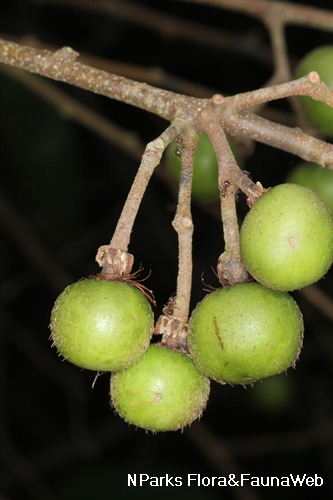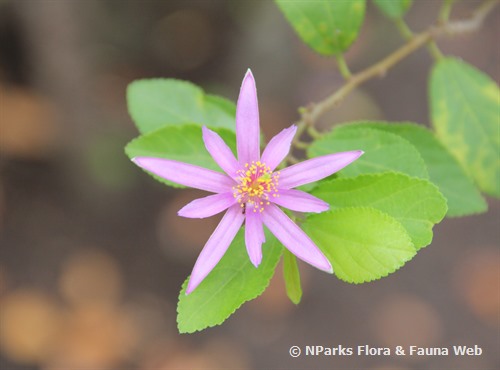
Back
Grewia laevigata Vahl
| Family Name: | Malvaceae |
| Synonyms: | Grewia acuminata Juss., Grewia umbellata Roxb. |
| Common Name: | Akar sekapu, Akar sempelas, 密齿扁担杆 |
Name
Classifications and Characteristics
| Plant Division | Angiosperms (Flowering Seed Plants) (Dicotyledon) |
|---|---|
| Plant Growth Form | Climber, Shrub |
| Lifespan (in Singapore) | Perennial |
| Mode of Nutrition | Autotrophic |
| Plant Shape | Irregular |
Biogeography
| Native Distribution | Thailand, Peninsular Malaysia, Singapore, and Borneo |
|---|---|
| Native Habitat | Terrestrial (Secondary Rainforest, Freshwater Swamp Forest) |
| Preferred Climate Zone | Tropical |
| Local Conservation Status | Native to Singapore (Vulnerable (VU)) |
Description and Ethnobotany
| Growth Form | It is a climbing shrub up to 15 m long. |
|---|---|
| Foliage | Its alternate, stalked leaves have slightly leathery leaf blades that are oval or oblong-egg-shaped, pale below, and 7.6-11 by 3.8-5 cm. |
| Flowers | Its yellowish-white flowers are 1.9 cm long, and grow in clusters of 6-8. |
| Fruit | Its green fruits are round, and contain one seed each. |
| Habitat | It grows in secondary forests. It occurs locally in Nee Soon Swamp Forest, in the vicinity of Upper Pierce Reservoir, and the Mandai Road area. |
| Associated Fauna | Its flowers are insect-pollinated. It is the preferred local food plant for caterpillars of the moths, Androlymnia emarginata, Anomis sabulifera, Churia nigrisigna, and Notarcha quaternalis. |
| Cultivation | It can be propagated by seed. |
| Etymology | Latin Grewia, commemorating Nehemiah Grew (1641-1712), an English microscopist; Latin laevigata, smooth, the reference to which is unknown |
Landscaping Features
| Landscaping | It may be suitable for parks. |
|---|---|
| Desirable Plant Features | Ornamental Flowers |
| Landscape Uses | General, Parks & Gardens |
Fauna, Pollination and Dispersal
| Fauna Pollination Dispersal Associated Fauna | Caterpillar Moth Food Plant (Leaves) |
|---|---|
| Pollination Method(s) | Biotic (Fauna) |
| Seed or Spore Dispersal | Biotic (Fauna) |
Plant Care and Propagation
| Light Preference | Full Sun, Semi-Shade |
|---|---|
| Water Preference | Moderate Water |
| Plant Growth Rate | Fast to Moderate |
| Rootzone Tolerance | Moist Soils, Well-Drained Soils |
Foliar
| Foliage Retention | Evergreen |
|---|---|
| Mature Foliage Colour(s) | Green |
| Mature Foliage Texture(s) | Leathery |
| Foliar Type | Simple / Unifoliate |
| Foliar Arrangement Along Stem | Alternate |
| Foliar Attachment to Stem | Petiolate |
| Foliar Shape(s) | Non-Palm Foliage (Ovate, Obovate, Oblong) |
| Foliar Venation | Pinnate / Net |
| Foliar Margin | Serrate / Toothed |
Floral (Angiosperm)
| Flower & Plant Sexuality | Bisexual Flowers |
| Flower Colour(s) | White |
|---|---|
| Flower Grouping | Cluster / Inflorescence |
| Flower Symmetry | Radial |
Fruit, Seed and Spore
| Mature Fruit Colour(s) | Blue, Green, Green - Bluish Green, Mauve, Red |
|---|---|
| Mature Fruit Texture(s) | Glossy / Shiny, Papery, Rough, Scaly, Hairy / Hirsute |
| Fruit Classification | Simple Fruit |
Image Repository
Others
| Master ID | 111 |
|---|---|
| Species ID | 1407 |
| Flora Disclaimer | The information in this website has been compiled from reliable sources, such as reference works on medicinal plants. It is not a substitute for medical advice or treatment and NParks does not purport to provide any medical advice. Readers should always consult his/her physician before using or consuming a plant for medicinal purposes. |



